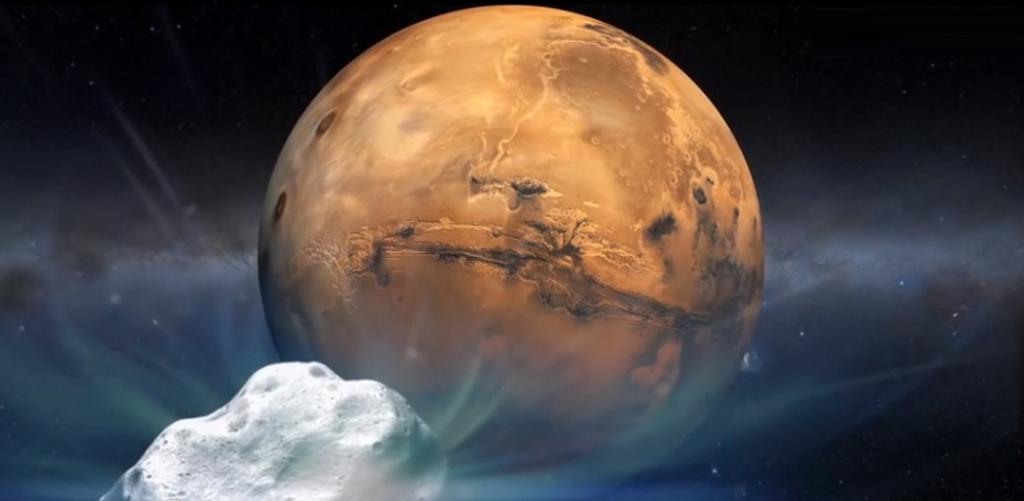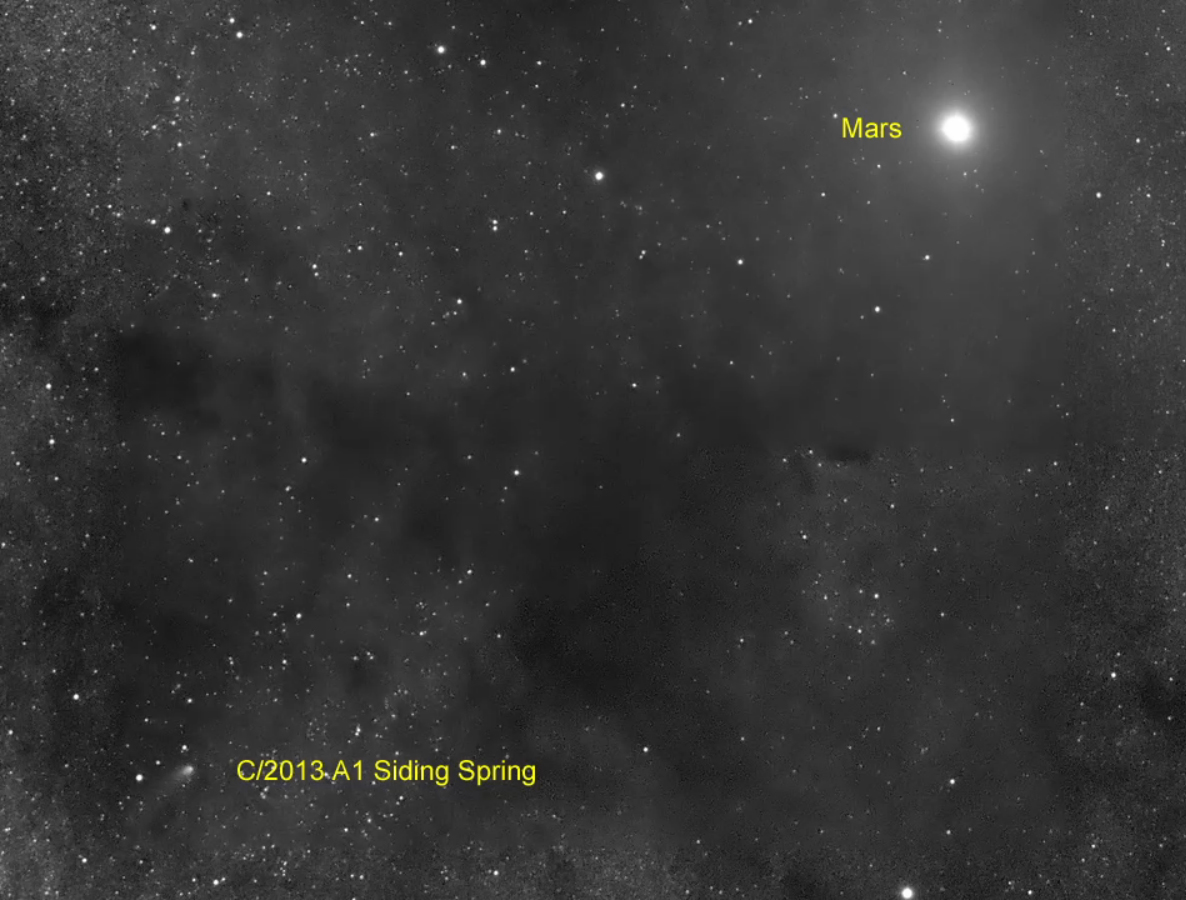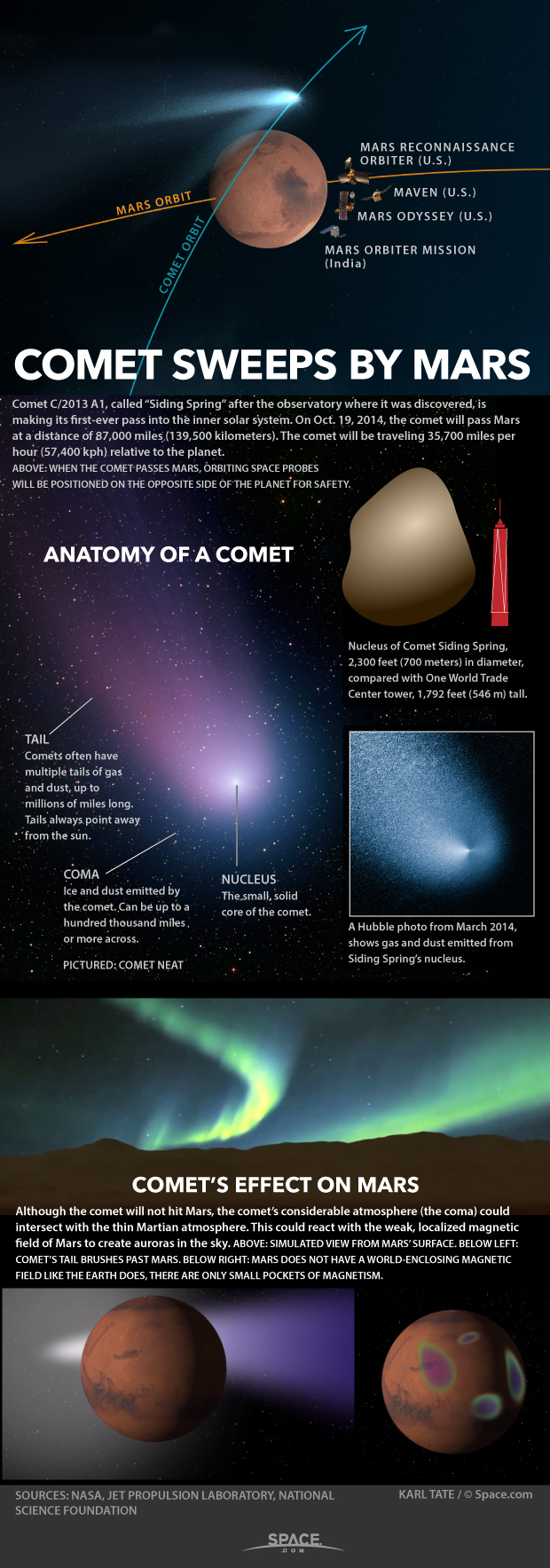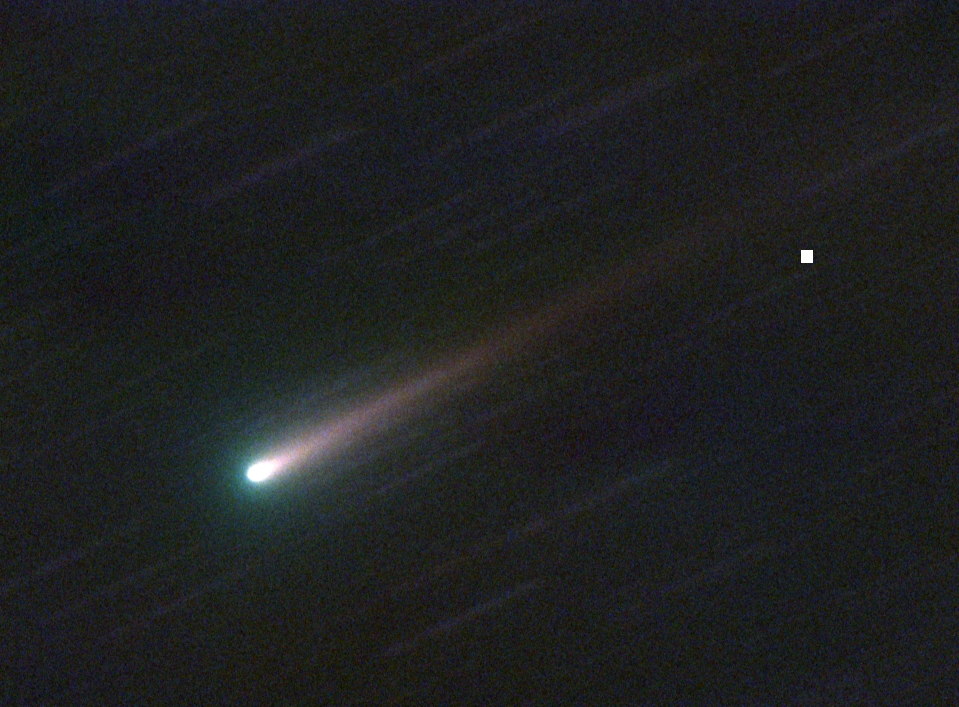
A comet zoomed by Mars today (Oct. 19) in an extremely rare close encounter that scientists billed as a "once-in-a-lifetime" event that may help researchers better understand the earliest days of our solar system.
Comet Siding Spring came within just 87,000 miles (139,500 kilometers) of the Martian surface at 2:27 p.m. EDT (1827 GMT) today — about one-third of the distance between Earth and the moon. At the time of closest approach, the comet barreled by at 126,000 mph (203,000 km/h) relative to the Red Planet, NASA officials said.
All seven spacecraft currently operating on or around Mars were scheduled to observe the close shave, with the aim of learning more about comet composition and behavior. [See photos of Comet Siding Spring]

"We cannot plan missions to comets like this — this one was discovered less than two years ago. It is incredible luck that it is saving us the trouble of going to it, as it flies by Mars, which is being explored by seven active robots," Mark Lemmon of Texas A&M University, a camera team member for NASA's Curiosity and Opportunity Mars rovers, said in a statement. "So this very much is a once-in-a-lifetime event, for us and our rovers."
Planetary scientist David Grinspoon, who tracked Comet Siding Spring flyby in real-time during a live webcast by the Slooh Community Observatory, compared the significance of the event with the epic impact of Comet Shoemaker-Levy 9 with Jupiter in 1994.
"It's very rare," Grinspoon said of such a close encounter between a comet and planet. "And it's certainly the first time that I can think of that I've seen it happen with Mars."
A unique opportunity

Comets are time capsules of a sort, remnants left over from the solar system's formation 4.6 billion years ago. Studying them can reveal insights about the conditions prevailing when the planets first started coming together, researchers say.
Get the Space.com Newsletter
Breaking space news, the latest updates on rocket launches, skywatching events and more!
And Siding Spring, which was discovered in January 2013, is an especially pristine time capsule. It's making its first-ever trip to the inner solar system from the Oort Cloud, a shell of trillions of comets that lies perhaps 50,000 astronomical units from the sun. (One astronomical unit, or AU, is the distance from Earth to the sun —about 93 million miles, or 150 million km.)
Siding Spring — whose core is between 0.5 and 5 miles (0.8 to 8 km) wide — has never been baked by the sun, so the comet likely looks much as it did 4.6 billion years ago.
Today's Mars flyby therefore presented a unique opportunity, scientists say. No space mission has ever visited an Oort Cloud comet; indeed, the core of such a body has never been resolved in an image before.
"NASA's Planetary Science assets – including the MAVEN spacecraft which just entered Mars’ orbit last month – are in prime positions to gather data and record this once-in-a-lifetime phenomenon," Congressman Lamar Smith (R-Texas), chairman of the House Science, Space, and Technology Committee, said in a statement after the comet flyby. "These are the events that inspire our imaginations and remind us why we must continue investing in planetary science and NASA's primary mission of space exploration."
NASA's Mars Reconnaissance Orbiter (MRO) aimed to photograph Siding Spring's core today. Curiosity and Opportunity were going to try to make history as well, capturing the first-ever images of a comet from the surface of another world.
"Opportunity and Curiosity are on opposite sides of the planet," Lemmon said. "Opportunity will take images from the surface in the dawn twilight, hours before the comet buzzes Mars. After the sun sets on the other side of the planet, Curiosity will take pictures as the comet departs Mars."
NASA's Mars Odyssey and newly arrived MAVEN spacecraft (short for Mars Atmosphere and Volatile Evolution), India's Mangalyaan orbiter and Europe's Mars Express probe were also slated to observe the encounter from orbit. MAVEN is especially suited to study any interaction between Siding Spring's dust and Mars' upper atmosphere, which could reveal insights about the Red Planet's air.
While a collision with any shed cometary material could result in serious damage, NASA officials are not too worried about their spacecraft. The orbiters were moved to be on Mars' "safe side" during the time of highest dust exposure, and Curiosity and Opportunity are protected by the planet's atmosphere.

Results coming soon
Don't expect the most spectacular images of the comet encounter to pop up on NASA's website right away. It will likely take a few days to receive and process data from the various Mars probes, researchers said.
"The best data probably won't actually be available until about three or four days after [closest approach]," Carey Lisse, a senior astrophysicist at the Johns Hopkins University Applied Physics Laboratory in Laurel, Maryland, said during a NASA news conference last week. "We don't want to over-promise."
The flyby data are part of a larger Siding Spring observation campaign, which began well before today and will continue as the comet heads back out toward the Oort Cloud. (Siding Spring's closest approach to the sun comes on Oct. 25.)
Analyzing the data gathered during this campaign could keep researchers busy for years to come.
"There are so many observations involved," said Kelly Fast, program scientist at NASA's planetary science division. "The science analysis will go on for a long time, especially to get all the science out of all the data that aren't necessarily pictures."
Follow Mike Wall on Twitter @michaeldwall and Google+. Follow us @Spacedotcom, Facebook or Google+. Originally published on Space.com.
Join our Space Forums to keep talking space on the latest missions, night sky and more! And if you have a news tip, correction or comment, let us know at: community@space.com.

Michael Wall is a Senior Space Writer with Space.com and joined the team in 2010. He primarily covers exoplanets, spaceflight and military space, but has been known to dabble in the space art beat. His book about the search for alien life, "Out There," was published on Nov. 13, 2018. Before becoming a science writer, Michael worked as a herpetologist and wildlife biologist. He has a Ph.D. in evolutionary biology from the University of Sydney, Australia, a bachelor's degree from the University of Arizona, and a graduate certificate in science writing from the University of California, Santa Cruz. To find out what his latest project is, you can follow Michael on Twitter.









